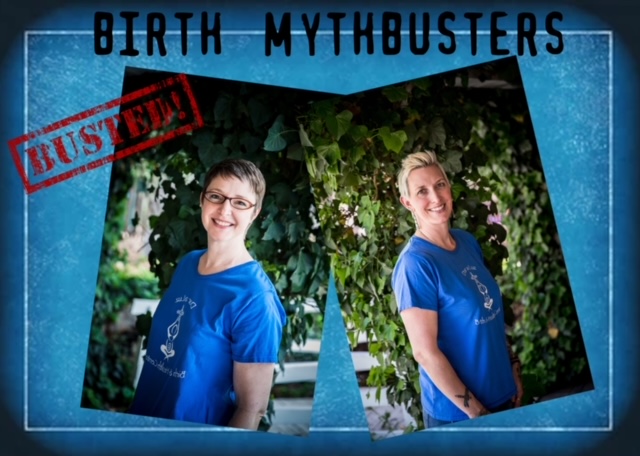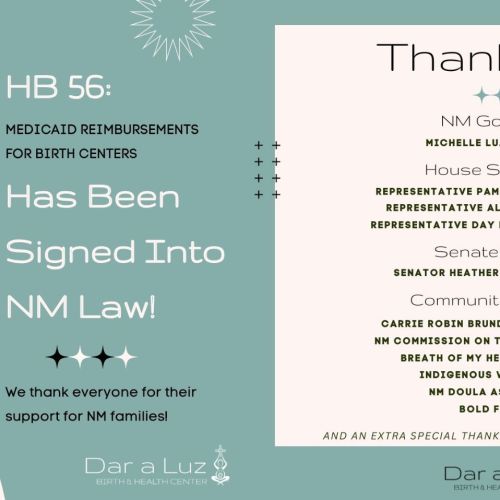Mythbusters: Birth Edition
by Alisa Henning, CNM
image by Lori Martinez Photography
Thanks for joining us on this myth-busting and truth-finding mission! Read on to learn more about birth and midwifery and birth center care.
“Birth has always happened in the hospital with doctors.”
Prior to around 1940, most births happened at home, and most were attended by midwives. In 1900, midwives still delivered half of all US births, but by 1930, this number dropped to less than 15% of US births. Today, only about 8% of births are attended by midwives in the US and only about 1% occur at home or at a birth center.
- 1900: Less than 5 percent of women gave birth in hospital
- 1935: Thirty-seven percent of births occurred in hospitals
- 1950: Eighty-eight percent of births occurred in hospitals
- 1960: Ninety-seven percent of births occurred in hospitals
Planned out-of-hospital birth (home or birth center) has remained at about 1% since the 1980’s.
“The United States of America has great prenatal and birth care, and is ranked one of the safest countries to give birth.”
Despite the United States spending the most on healthcare, including birth care, we have some of the worst outcomes in the developed world for moms and babies. According to the CDC, the 2020 maternal death rate was 23.8 deaths per 100,000 live births. This rate has been increasing steadily since 2000. This rate puts the US ranking 55th when compared to all other countries, from the data that is kept. For contrast, the countries with the fewest maternal deaths per birth are the Netherlands, Norway, and New Zealand; each of these countries have less than 3 deaths per 100,000 live births. Also, the Netherlands touts the highest rates of out-of-hospital birth with midwives (i.e. births at home and at birth centers) with rates at about 40%! Some argue that the causes of these outcomes have many factors, and the data is difficult to compile. However, it has been proven time and again that the countries that utilize midwives for most of their birth care consistently experience much better outcomes. For instance, in the three countries with the best outcomes (Netherlands, Norway, and New Zealand) midwives attended 75-80% of births. This is in stark contrast to the US, where only about 8% of births per year are attended by midwives.
Another study in the US found that the states that integrate midwives into their healthcare systems the most, including Washington, New Mexico, and Oregon, have some of the best outcomes for mothers and babies. Conversely, states with the most restrictive midwife laws and practices, including Alabama, Ohio, and Mississippi, tend to have worse outcomes for maternal and neonatal well-being.
Don’t take our word for it — here are some recommendations for addressing the US maternal health crisis.
From an article from the Commonwealth Fund:
“The U.S. has the highest maternal mortality rate among developed countries. Obstetrician-gynecologists (ob-gyns) are overrepresented in [the United State’s] maternity care workforce relative to midwives, and there is an overall shortage of maternity care providers (both ob-gyns and midwives) relative to births. In most other countries, midwives outnumber ob-gyns by severalfold, and primary care plays a central role in the health system. Although a large share of its maternal deaths occur postbirth, the U.S. is the only country not to guarantee access to provider home visits or paid parental leave in the postpartum period.
“In most other countries, however, midwives greatly outnumber ob-gyns. For example, midwives provide most prenatal care and deliveries in the U.K. and the Netherlands — countries considered to have among the strongest primary care systems in Europe.”
The World Health Organization (WHO):
WHO recommends midwives as an evidence-based approach to reducing maternal mortality. Several systematic reviews have found that midwifery-led care for women with healthy pregnancies is comparable or preferable to physician-led care in terms of:
- Maternal (mother) and neonatal (baby) outcomes, including lower maternal mortality and morbidity and reduced stillbirths and preterm births
- More efficient use of health system resources, including lower use of unnecessary and potentially harmful interventions like C-sections for low-risk deliveries, epidurals, and instrument-assisted births
- Improved patient satisfaction and maternal psychosocial well-being outcomes, including those for postpartum depression.
Some experts note that “high-income countries with the lowest intervention rates, best outcomes, and lowest costs have integrated midwifery-led care” into their health care systems.”
The American Public Health Association (APHA):
The APHA has publicly supported the use of innovative strategies to improve birth outcomes and decrease maternal and newborn morbidity and mortality. In terms of quality, satisfaction, and costs, the midwifery model for pregnancy and maternity care has been found to be beneficial to women and families, resulting in good outcomes and cost savings. With its focus on pregnancy as a normal life event and health promotion for women of all ages, the midwifery model of care is an appropriate alternative or complement to the medical approach to childbirth.”
“A doula and a midwife are the same.”
Midwives are healthcare professionals who are providing your medical care during your pregnancy, birth, and postpartum period, and “catching” your baby (midwives usually say “catch,” while doctors usually say “deliver”).
A doula is not a medical professional, but a trained helper who provides emotional and physical support to the family during pregnancy, birth, and postpartum. Doulas are hired separately, and are not included in your Dar a Luz care. We love doulas and welcome them to the center, and we believe in them so much that we even have a transfer doula program for our clients who need to birth in the hospital.
“Midwives are uneducated and/or untrained.”
There are two main types of midwives in the United States. These are Direct Entry Midwives, also known as Certified Professional Midwives (CPM/CM) and Certified Nurse-Midwives (CNM).
A CPM is trained to provide midwifery care to people during pregnancy, birth, and postpartum, and to care for newborns. CPMs must meet specific education requirements and pass a certification exam with the North American Registry of Midwives. They are currently able to be licensed in 35 states.
A CNM is a primary health care professional who first receives their Bachelor’s degree and training in nursing, and then goes on to complete a graduate degree (a Master’s degree or a doctorate) in the midwifery specialty from an accredited university, and must then pass the National Midwifery Board Certification Examination.
CNMs provide holistic primary care in the form of gynecologic and family planning services, as well as preconception, pregnancy, childbirth, postpartum, and newborn care. CNMs are licensed in all 50 states and can write prescriptions. In many states, including New Mexico, CNMs are licensed as independent practitioners.
All midwives at Dar a Luz Birth & Health Center are CNMs who go through even more extensive training for the birth center/Dar a Luz model of care.
“Birth center and midwifery care are safe.”
There are a multitude of studies about midwifery and birth center care that prove the safety of these options.
Here are a few quotes from a several sources:
From the National Academies of Sciences:
“Home and birth center births have lower rates of interventions than hospital births, such as cesarean birth or induction of labor. This means women giving birth at home or in birth centers also have lower rates of intervention-related injuries and complications, such as infection or postpartum hemorrhage.”
From The Journal of Nurse-Midwifery (several different articles):
“For low-risk pregnancies, birth centers confer many advantages over conventional hospital-based births without compromising the safety of the mother or infant and in the process can empower women to transform their lives and their community.”
“Women beginning labor in a birth center had significantly-improved quantitative measures of satisfaction when compared with women planning hospital births. Significantly more women in the birth center group felt that antepartum care raised their self-esteem and that they would use the same model in the future.”
“Women in birth center care were satisfied with the comprehensive, personalized care that they received and the overall environment of the center. Participants valued the connections with midwives. Women stated that their relationships with birth-center midwives were more egalitarian than with previous hospital providers, and this personal connection enabled them to be active participants in health care decisions. Participants in the Pewitt study felt that the close relationship with the birth center midwives care increased their confidence, and that their birth experiences demonstrated their capacity to handle life challenges. As a result of these experiences, they felt more confident as parents. Satisfaction with the relaxing birth center environment was a theme in 3 qualitative studies. Women were also pleased with the birth center physiologic approach to care in comparison with previous hospital experiences.”
Outcomes from the National Birth Center Study II (2007-2010):
“The C-section rate for low-risk women who chose to give birth at a birth center was only 6% —compared to the U.S. C-section rate of 27% for low-risk women. This means that the C-section rate for women in birth centers is more than 4 times lower than what is seen among low-risk women in the U.S.”
Transfer Rates from the National Birth Center II Study:
- 4.5% were referred to a hospital before being admitted to the birth center
- 11.9% transferred to the hospital during labor — most of the in-labor transfers were done for non-emergency reasons, such as prolonged labor. Less than 1% were transferred to the hospital during labor for emergency reasons.
- 2.0% transferred after giving birth
- 2.2% had their babies transferred after birth
Dar a Luz Average Statistics:
- 2-3% were referred to a hospital before being admitted to the birth center
- 10% transferred to the hospital during labor — most of the in-labor transfers were done for non-emergency reasons, such as prolonged labor.
- Less than 1% were transferred to the hospital during labor for emergency reasons.
- 2% transferred after giving birth2-3% had their babies transferred after birth10% c-section rate
“I cannot come to Dar a Luz for midwife care if I am not pregnant.”
All of the midwives at Dar a Luz are Certified Nurse-Midwives, and we provide many gynecological and well-woman services. We provide annual well exams, Pap testing, STI testing, contraception counseling, and prescriptions, and we can place IUDs. We also can evaluate other issues like breast masses, potential urinary tract infections, and unusual vaginal discharge.
“I would love to birth at Dar a Luz, but they don’t take insurance.”
Dar a Luz Birth & Health Center accepts most private insurances, Tricare, and Medicaid. We even have a wonderful Billing Specialist, Erica Deerinwater, who will check your insurance benefits before you start care with us and provide you with a personalized estimate based on your insurance policy!
“I can’t give birth at a birth center if I’ve had a C-section.”
If you have had more than one c-section in the past, you are not low-risk enough to be eligible for a Dar a Luz birth.
However, if you have had only one previous c-section with the most common low incision, then you are absolutely eligible for a Dar a Luz care (dependent on the same eligibility safety criteria as all of our pregnant clients, of course). We at Dar a Luz are passionate about making sure that VBAC (vaginal birth after cesarean) remains a safe option at our center.
To check to see if you can come for Dar a Luz care, please check out our eligibility lists on our website.
“If I have my baby at Dar a Luz, I must do it “natural” or unmedicated. What if I need pain medication?”
We have so many tools in our toolbox to help you manage your labor!
For starters, you will not be in bed on your back with a continuous fetal monitoring device strapped to your abdomen, which is common practice in many hospitals. Instead, you will be up and mobile and free to change positions as you would like, and we will monitor the baby’s heart rate by listening at regular intervals with a Doppler device (which has been proven to be just as safe as continuous fetal monitoring). We will provide support as you need it. This, in and of itself, is a major advantage when it comes to coping with labor contractions!
We also have our specially-designed birth tubs for hydrotherapy and waterbirth. Using water in labor and/or when giving birth has been proven many times over to reduce pain for the laboring person and increase their satisfaction with their birth. Other tools we can utilize are labor balls, the rebozo (a Mexican scarf technique), the labor sling, TENS units, massage, and hot packs.
For those who do need or desire medication for coping with labor, you also have the option to use nitrous oxide (laughing gas) and/or IV pain medications.
Every labor is unique, and we pride ourselves in providing individualized care!
“Waterbirth is not scientifically supported.”
There have been many studies and literature reviews about waterbirth!
- Some benefits for the birthing person include:
- Less pain and higher satisfaction with the birth experience
- Less medication use for pain relief
- Less use of artificial oxytocin and possibly shorter labors
- Higher rates of normal vaginal birth
- Lower rates of episiotomy
- Higher rates of intact perineum, especially in high-episiotomy settings
- Possibly lower rates of severe tears (3rd or 4th degree), especially in high-episiotomy settings
Waterbirth is also safe for baby:
- No increase in newborn death or any other bad health outcome
- No increase in NICU admissions
- No increase in low Apgar scores
- No increase in breathing difficulty or need for resuscitation
- No increase in infection
For an in-depth review of waterbirth, please visit Evidence Based Birth
“Dar a Luz is the only accredited facility in all of New Mexico that offers waterbirth.”
Dar a Luz Birth & Health Center is currently the only birth center in all of New Mexico accredited by the American Association of Birth Centers (AABC), and we offer waterbirth.
“Meeting the standards of accreditation indicates to clients, states, health and liability insurance agencies, consulting providers, and hospitals that a birth center has met a high standard of evidence-based and widely recognized benchmarks for maternity care, neonatal care, business operations, and safety.”
The American Association of Birth Centers (AABC)
The majority of our clients choose to use the birth tub for hydrotherapy during their labor, and about 60% of people birth in our tubs. None of the hospitals offer waterbirth. Some will “allow” patients to labor in a tub, which is often a normal-sized bathtub that is not suitable for proper hydrotherapy for pain relief; but hospitals will not “allow” your birth to happen in the tub. (Lovelace Women’s Hospital did offer waterbirth for a short time some years ago, but that is NOT an option any longer.)
“Dar a Luz Birth & Health Center is a safe and welcoming place for care and birth!”
Here are just a few reviews from our clients!
“Had my last baby there during the peak of the pandemic and never had a more welcomed, warm, SAFE ENVIRONMENT. If you’re nervous about natural childbirth, this is the place for you.”
“Dar a Luz is amazing. I birthed my baby there and it was the most amazing experience of my life. The prenatal care that was provided through my pregnancy was everything I had dreamed of. I felt so safe and heard by everyone there.“
“I am forever thankful for the care that Dar a Luz provided me during my pregnancy and postpartum. The warm and welcoming environment of their facility beats the doctor’s office any day.”
“Care at Dar a Luz is an example of what all care should look like.”
“The facility is relaxing, homey, and welcoming, as well as clean and professional. I have never felt more relaxed while receiving health care.”
“Throughout my prenatal care and birth I was continuously impressed by the midwives, nurses, and staff. Everyone was so kind, supportive, and knowledgeable.”
“I can’t think of a better way to bring a baby into this world!”
“I cannot say enough about how beautiful and empowering my births have been there. I feel so safe and supported at DAL, almost like I’m a part of a family. The facility is beautiful and comfortable and the staff are professional and loving. I adore everyone who works there!”
We hope this has been informative and helpful! Be sure to reach out if you have any questions.

Alisa Henning, CNM is a co-founder of Dar a Luz and returned in 2018. She is a staff Midwife and the Clinical Director of the center. Raised in Little Rock, Arkansas, she became a nurse in 2000 and recieved her Masters degree in midwifery from UNM in 2005. Out-of-hospital birth has always been one of her true passions. She lives in Albuquerque with her family (including triplets) and enjoys hiking.









